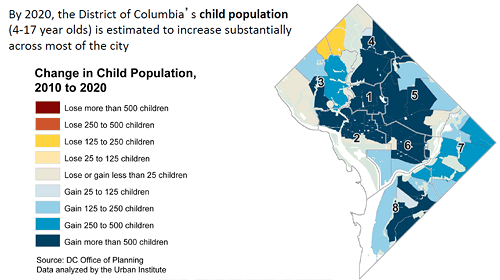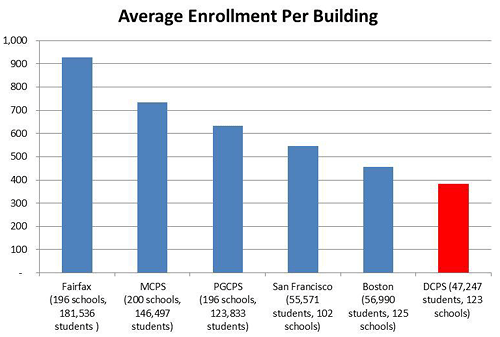DCPS closing 20 schools, including Spingarn
Chancellor Kaya Henderson announced today that DC Public Schools will close 20 of its schools in a long-anticipated move based, she said, primarily on right-sizing DCPS’s capacity with its enrollment and educating more kids in modernized campuses.
The only high school slated to close is also the high school most in the transportation news: Spingarn High School, on Benning Road. DDOT has been planning a streetcar maintenance facility on the Spingarn grounds, and hoped to provide technical training in streetcar technology for Spingarn students.
Henderson said that this idea isn’t gone; DCPS is looking into creating a “transportation career and technical education center” at Spingarn, but this plan is still in the early stages.
Matt Johnson made some maps of the proposed closures for neighborhood elementary, middle and high schools. There are also some schools that serve students with disabilities or other specialized groups which are not on these maps as they do not draw from neighborhood boundaries.
Henderson said that DCPS hopes to keep all of the school buildings for the future. The Office of Planning estimates that the number of school-age children in DC, which has been declining for many years, will start rising again in 2015. Therefore, DCPS will likely begin needing more of these schools once more, but not for at least some years.
DCPS has plans for some of the buildings, such as expanding School Without Walls into the Francis-Stevens Education Campus, which is slated for closure. There are some preliminary ideas for some others, like a suggestion for a community arts center in what’s now Garrison Elementary. For many, DCPS plans to work with the local community to identify the best use of the building, possibly including housing charter schools in the buildings.
Earlier this year, a report from IFF, a community development and consulting organization, recommended closing many schools with lower rates of student proficiency and moving kids to schools with higher proficiency. This report came under a lot of criticism for allegely oversimplifying and misreading the statistics.
At today’s press conference, Henderson made no reference to the IFF report, and when asked said she had seen the data, but it wasn’t the basis for her decisions. Instead, she talked about the Census and about data from the Office of Planning, and claimed that she made decisions to close schools simply to align the supply of space with the student demand.
Many families have been “voting with their feet” and moving to charter schools, and in Wards 1, 5, and 6, the majority of students now attend charter schools. Plus, the population of school-age children has been declining. However, forecasts estimate that there will be many more kids by 2020 in many parts of the District.
The demographic trends and growing charter school demand mean DCPS has much more space than it needs right now, and Henderson said this round of school closings is entirely about addressing that mismatch, not about the theory that closing schools with poorly-performing kids and moving them to a different school will make them perform better. One could as easily argue that such a move would instead make the new schools’ test score numbers decline, because while a school can have a lot of impact on a kid’s test scores, it’s far from the only factor.
DCPS has modernized 47 of its 117 buildings since 2007, but 20,000 students still attend the schools that haven’t gotten modernized yet. Kids at Ron Brown Middle School in Ward 7, for instance, will go to the recently-modernized Kelly Miller Middle School.
The changes also mean that DCPS is moving away from the model of having pre-K through 8th grade education campuses, such as Francis-Stevens, whose elementary kids will go to Marie Reed while middle schoolers will go to Hardy, and Winston education campus, which is splitting its elementary and middle school students into Stanton Elementary and Kramer Middle School.
Meanwhile, MacFarland Middle School will now move to Roosevelt High School (preventing the idea some have floated of moving Duke Ellington School of the Arts to the unused space at Roosevelt), and Shaw Middle School will locate with Cardozo High.
DCPS’ presentation notes that it has the fewest average kids per school building, 384.12 of any jurisdiction in the region; Fairfax County has 926.2 kids per building.
This brings costs to DCPS, though fewer, larger schools also means fewer kids can walk to their neighborhood school. In the suburbs, families travel very large distances by car to go to school, often to the detriment of public health and traffic congestion.
Here is a full list of the schools slated for closure:
High schools:
- Spingarn (to Eastern, Dunbar, Woodson)
Middle schools:
- Francis-Stevens (to Hardy)
- MacFarland (to Roosevelt)
- Shaw at Garnet-Patterson (to Cardozo)
- Johnson (to Hart and Kramer)
- Winston (to Kramer)
- Francis-Stevens (to Marie Reed)
- Garrison (to Seaton)
- Marshall (to Langton)
- Davis (to C.W. Harris)
- Kenilworth (to Houston)
- Smothers (to Aiton and Plummer)
- Winston (to Stanton)
- Ferebee-Hope (to Hendley)
- Malcolm X (to Turner)
- MC Terrell-McGogney (to King)
- Sharpe Health (to River Terrace)
- Mamie D Lee (to River Terrace)
- CHOICE at Hamilton (to Cardozo)
- Spingarn STAY (to Ballou STAY and Roosevelt STAY)
- Prospect LC (to neighborhood schools)





